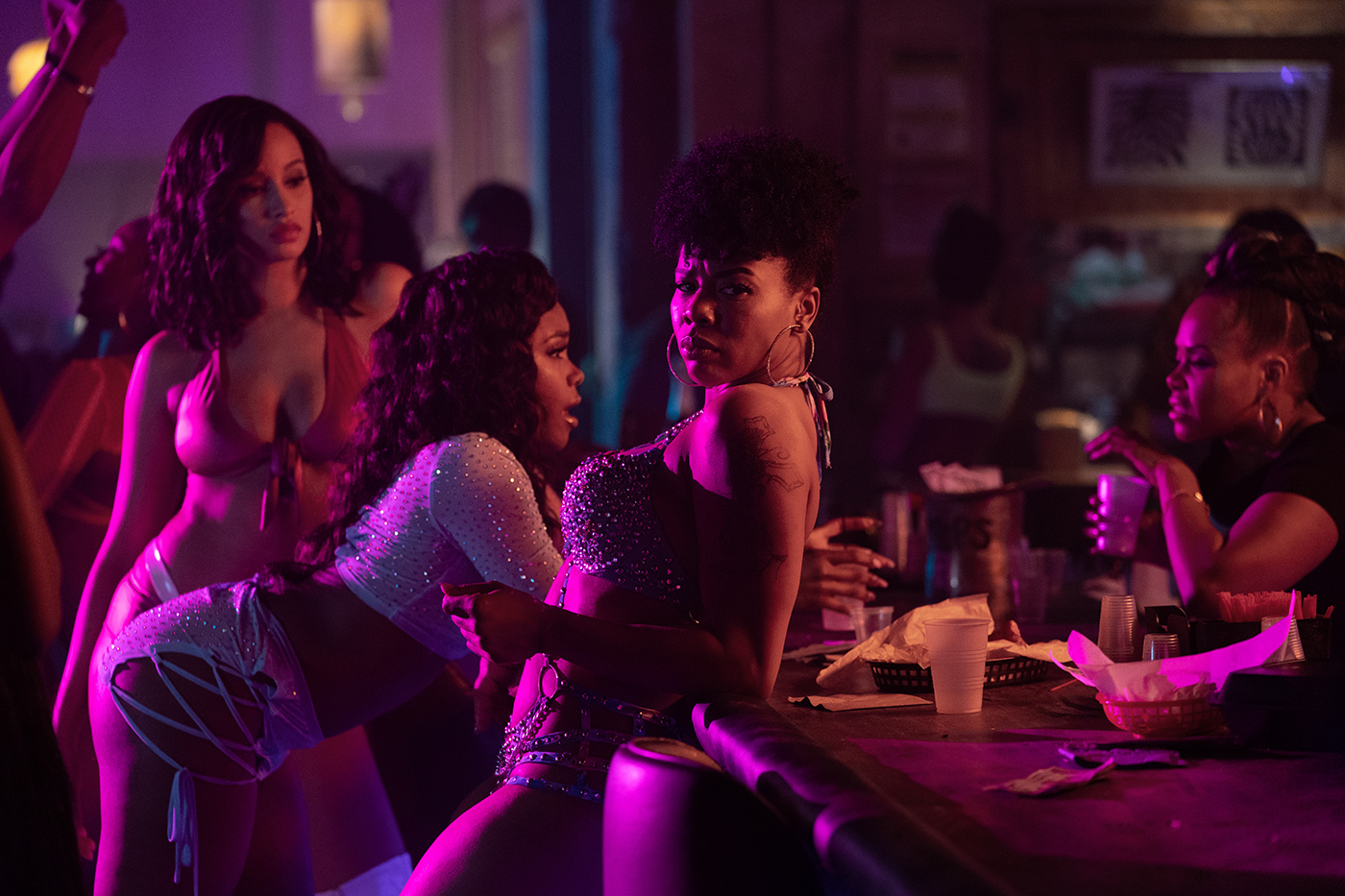Katori Hall’s new STARZ series, based on her empowerment of Black women in the Delta, reinvents film noir for a new generation.
by Valentina Valentini / Photos by Jessica Miglio, SMPSP / STARZ (unless otherwise noted)
In the first episode of P-Valley – a new drama on STARZ that follows strip-club dancers in the Mississippi Delta – we meet Autumn Night (Elarica Johnson), a young woman who is escaping a turbulent past. Autumn is pulling herself up by her bootstraps – or, in this case, her platform heels – to begin a new life. And while she doesn’t have a plan, per se, her quick wit and determination indicate better times are ahead.
P-Valley Creator/Showrunner Katori Hall shares a few character traits with Autumn Night – strength, ingenuity, creativity in survival. But unlike the character she created, this newcomer to television doesn’t do anything on the fly. When Hall’s theatrical production, Pussy Valley, which ran at Mixed Blood Theatre in Minneapolis in 2015, was to be made into a series, Hall immersed herself in the language of cinema – editing, cinematography and production design. Then she hired a team of filmmakers whose approach to visual storytelling would help illuminate the complexity of characters in P-Valley – a group of diverse people of color whose problems outside their beloved strip club, The Pynk, are only matched by the many power plays inside the venue.
Hall’s alternating directors of photography were a study in contrasts. Nancy Schreiber, ASC, started as a gaffer in New York City in the 1980s, shooting dozens of music videos, including Black artists like Aretha Franklin and Kool Moe Dee, while Richard Vialet, a younger Black filmmaker, born in the Virgin Islands, has shot indie features and music videos, including 9 Rides for Oscar-winner Matthew Cherry. The diverse camera crew included more than 50 percent women and people of color (and other departments, like longtime Key Grip Ray Brown’s team, were equally inclusive).
Production Designer Jeffrey Pratt Gordon, a veteran of John Waters’ Baltimore-set films, was in sync with his showrunner, down to the color of a character’s toothbrush. All of the eight episodes had a woman directing, with five of those being women of color. They shot at Tyler Perry Studios in Atlanta.
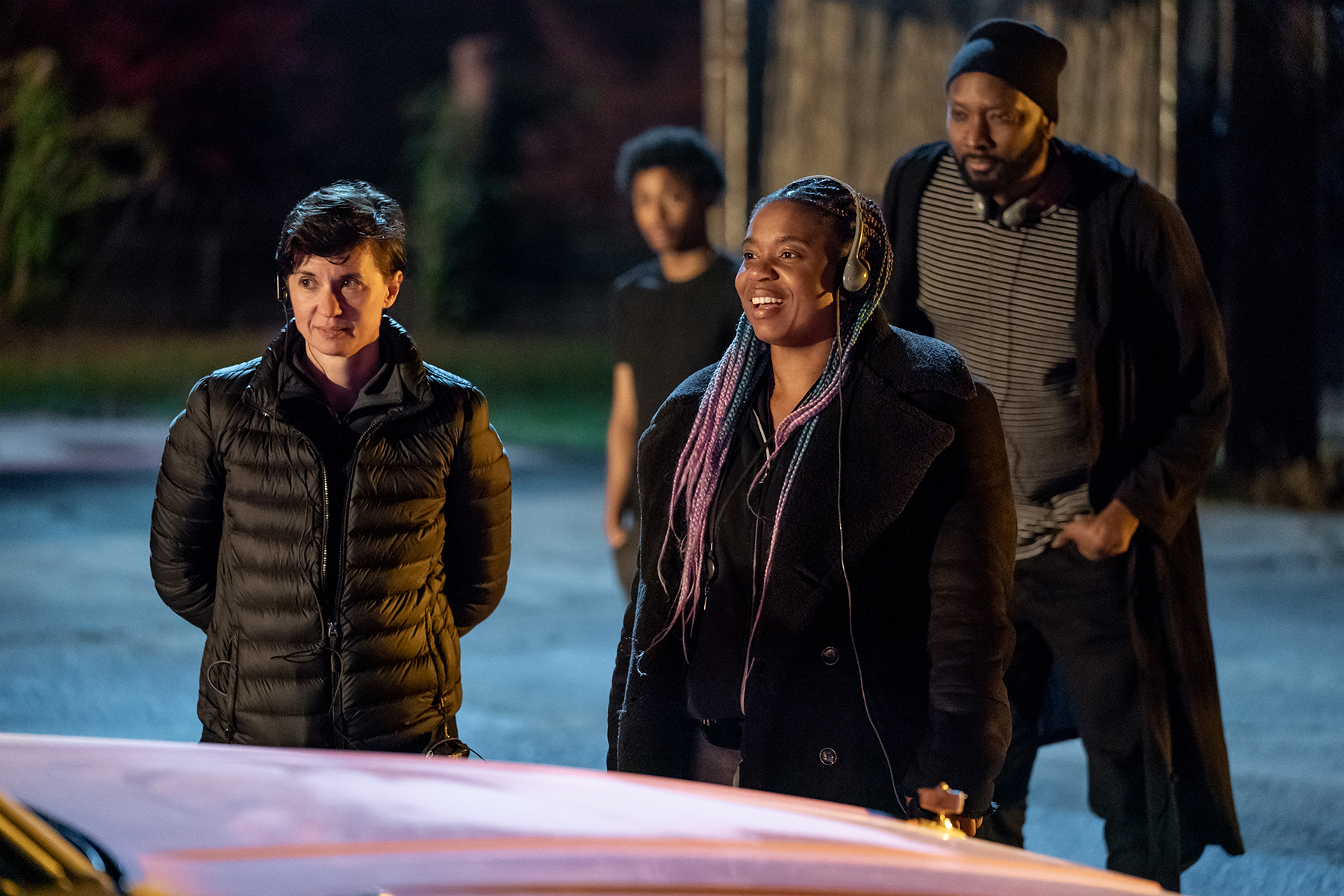
While inclusivity was built into the fabric of P-Valley, so was the directive to tell the story from the perspective of the young women who call The Pynk home. “During our interview, Katori had questions about how to avoid the male gaze,” Vialet recounts. “She wanted to avoid exploitation, and I completely agreed. I also did not want to exploit the way the dancers looked on camera, but at the same time, I didn’t want to treat what we were seeing on stage with kid gloves. These dancers are proud and powerful, and I felt the photography should support that.” Adds Schreiber: “Inside that club, we wanted to show these women in an element of power. Yes, we also shot the audience POV of the dancing, but it was never overtly sexual. We wanted the dancing to be shown in all its athleticism and its beauty; again, the power these women had when they were on stage needed to be shown in exact opposition to the challenging lives they had off stage.”
One of the goals for the P-Valley team was to create a new kind of cinematic noir. Hall gravitated to the noir genre growing up, citing black-and-white films like The Maltese Falcon and Sunset Boulevard as influences. And while the contrast of light and dark has always intrigued her, the male-centric focus of the genre and the stereotypical roles (think porter or housemaid) given to Black characters did not.
“Dark shadows tend to have a negative connotation,” Hall shares, “so I was interested in flipping the use of darkness on its head to embrace sharp contrast and shadow as a space of freedom. Black folks’ stories have rarely been treated with that elevated aesthetic, so I wanted to show that heightened visual story.”
Hall says gritty or potentially dangerous worlds, like that found in her Mississippi Delta location, often end up looking like those in documentaries. She wanted P-Valley to be more like classic Hollywood cinema and impressed upon her team that with every scene that there should be a flow. She called the look for the show “Delta Noir,” and urged her team to embrace bold colors and dark shadows, like those in modern neo-noir films Drive, Zodiac, Devil in a Blue Dress, and No Country for Old Men. “The visual divide is a reflection of the grit of the world that the women are living in and the magic of the stage,” Hall adds. “I wanted lots of color, and I also wanted to see the tropes of noir through the eyes of women, where they’re the detectives/hunters, and the men are being hunted.”
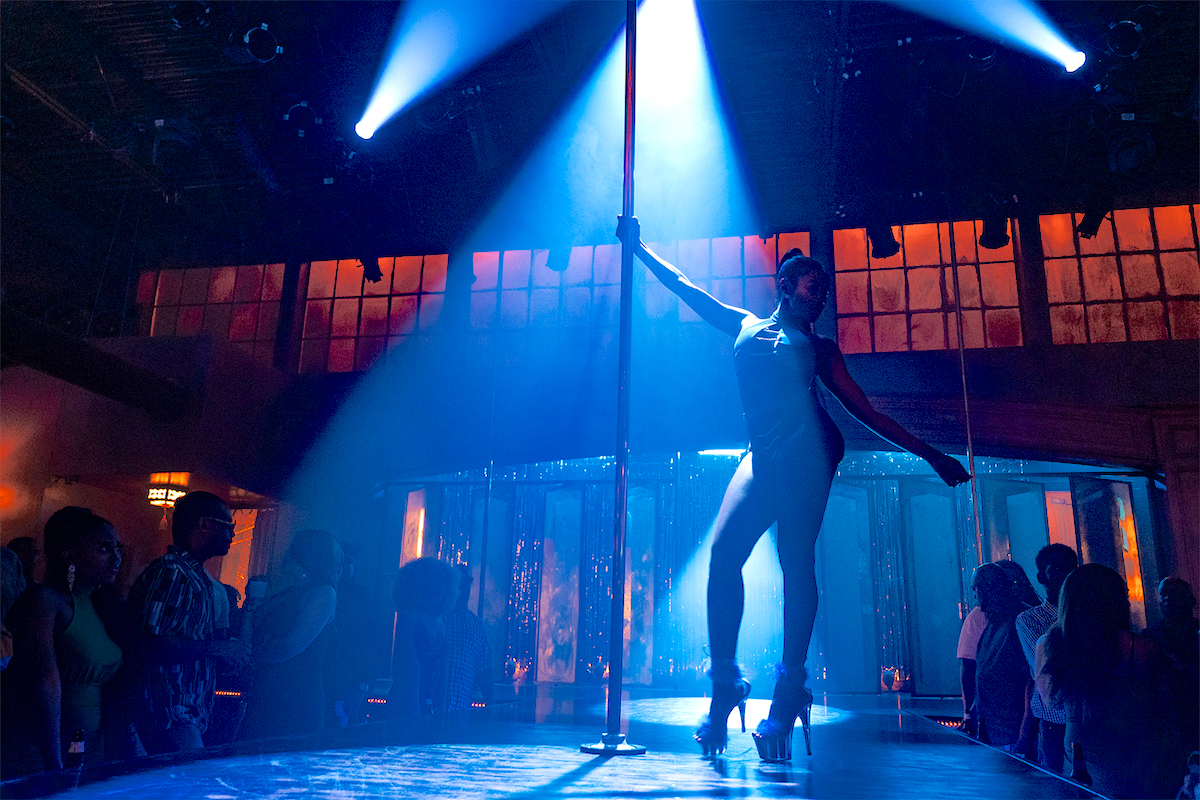
A-camera/Steadicam Operator Dave Chameides, SOC, with whom Schreiber has worked for decades and whom she praises for his versatility and incredible instincts when shooting movement and dance, says, “We tried not to shoot a TV show, which can be so formulaic. We never defaulted to a specific way of shooting. A lot of scenes played in one shot, and we were given full license to not shoot coverage if it served the story. Our amazing script supervisor, Amber Harley, was a huge asset in supporting these decisions.”
B-camera operator Janice Min, whose operating credits include the Emmy-winning House of Cards, says, “the show is about female empowerment, their sensuality and struggles as a family that comes together at The Pynk, and also with the familial ties they have outside the club. Within the greater overall vision Katori, Nancy and Richard had, I aimed to make my frames portray this dichotomy of strength and vulnerability, and to create a fluidity in their sensuality, power and kinship they share off and on the stage.”
Hall worked closely with Episode 1 Director Karena Evans, known for her expressive Drake music videos. From the many visual cues Hall included in her script, Evans created a 130-page look-book that became a show bible. “In our very first conversation,” Evans recalls, “Katori explained how Delta Noir takes the organizing principles of traditional film noir and does a twerk on them. Somehow, I knew exactly what she meant, and could easily see the world she was envisioning.”
Evans says that because Delta Noir is specific to Mississippi strip-club culture, she explored deep shadow play and high contrast, where characters moved in and out of pockets of light. Green was used sparingly (owing to Hall’s aversion), while pink and blue not only fit the club’s name but also enhanced the reflectivity and luminosity of Black skin tones. “I talked with Richard and Nancy about not using hard light for Black actors and using a lot of diffusion,” Hall adds. “I think there is this myth that to see Black people, particularly in dark places, you need to hit them with a lot of light. And we embraced the fact that it’s okay for Black people to be in dark spaces; it’s okay for them to step in and out of light, in and out of shadows. And that became a kind of a rule.”
For a scene in Episode 2, when the character Lil Murda (J. Alphonse Nicholson) is in the back of Uncle Clifford’s (Nicco Annan’s) car at night, Hall didn’t want to see Lil Murda’s face until after his voice was heard and he moved forward. “You’re doing Black people a disservice when you overexpose them,” Schreiber recalls, citing Bradford Young, ASC’s advice from years ago. “The range of skin tones of our actors was so nuanced and diverse. It was important to show that beautiful range of depth and tone when photographing our cast.
“Also, there has been a tendency to over-powder actors in film and television,” she adds, “but our embracing of natural shine brought out wonderful tonal variations. Plus, P-Valley is set in the hot South, where people are sweating, and no one has air conditioning.”
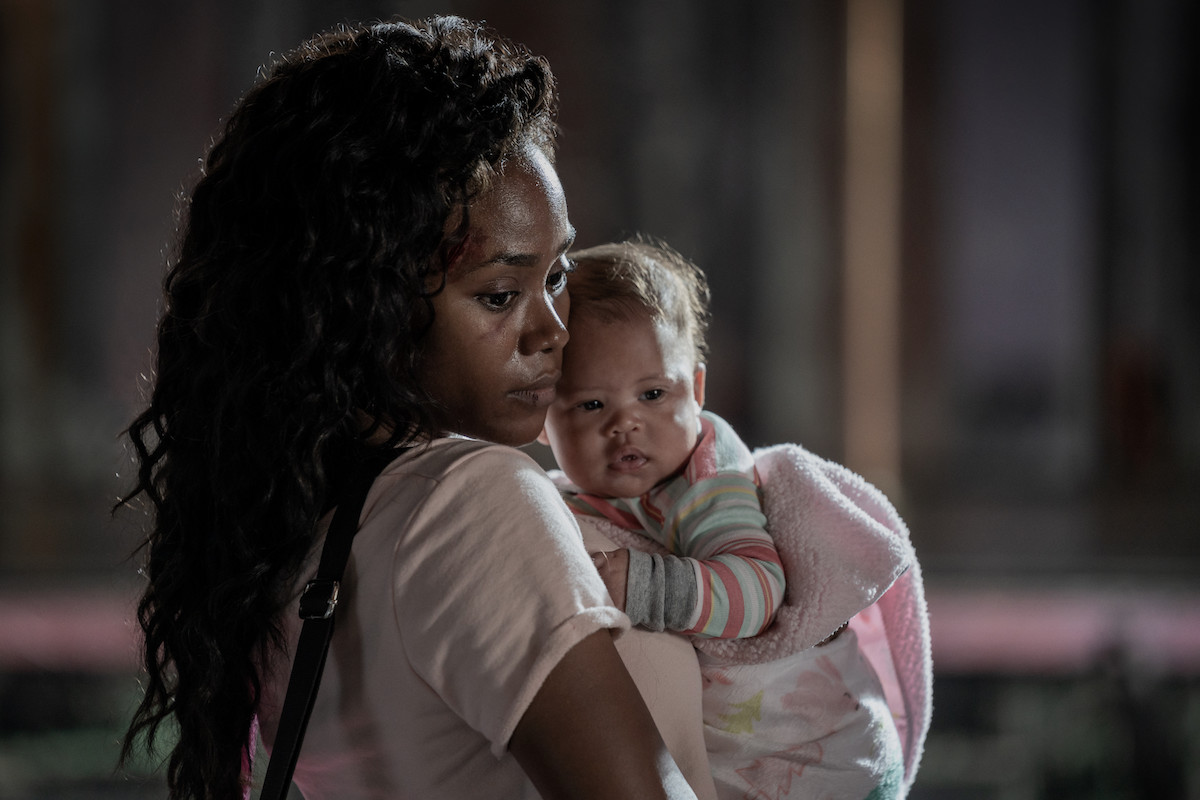
Chief Lighting Technician Jon Ladd was instrumental in providing Vialet and Schreiber a vast array of lighting color options. But because Hall’s mandate for the club was both sleek and gritty, Ladd’s challenge was sourcing state-of-the-art lighting while maintaining the weathered look of the club’s stage-lighting instruments. “This was a 1950s southern juke joint turned stylishly gritty strip club,” Ladd explains. “We knew RGBA LED’s were needed to design our colors and for quick access, but we had to figure out how to camouflage them on camera so they would appear as old, shabby fixtures.”
Schreiber and Vialet provided a show-and-tell of fixtures to the producers before ordering those units, “so that Katori would know we were staying close to the reality of Uncle Clifford’s economic situation,” adds Schreiber. Ladd’s team hid Astera AX10s in empty Par-can housings and used ETC Source Four Series 2 Lustr ellipsoidals – since ellipsoidals have been used in theaters and music venues since they originated in the 1930s. They sprinkled these lights around the club, many to zone-light the stage, with the AX10’s 45-degree diffusion disks for front light, ETC Lustr 2s for backlight. For the main-stage pole, they used the Lustrs as front light to make a dancer pop out. When it came to architectural points of interest, Ladd used Lustr 2s, which also helped control light on the patrons without having to place grip gear in the ceiling.
“We didn’t use any moving light effects in the club other than a spotlight in the final episode,” Ladd continues. “Katori, Nancy, Richard, and I agreed that we didn’t want the TV audience to ask themselves, ‘Where did this rundown strip club get all those fancy lights?’ We did rig four moving lights in the ceiling for use as stationary lights that we could adjust without having to bring ladders and lifts in or having to clear the extras off the floor. This meant they had to be hidden from camera, so we used the smallest moving lights on the market – two ROBE Robin Pointes and two Clay Paky Sharpys – strategically placed in the ceiling, one each on either side of the stage.”
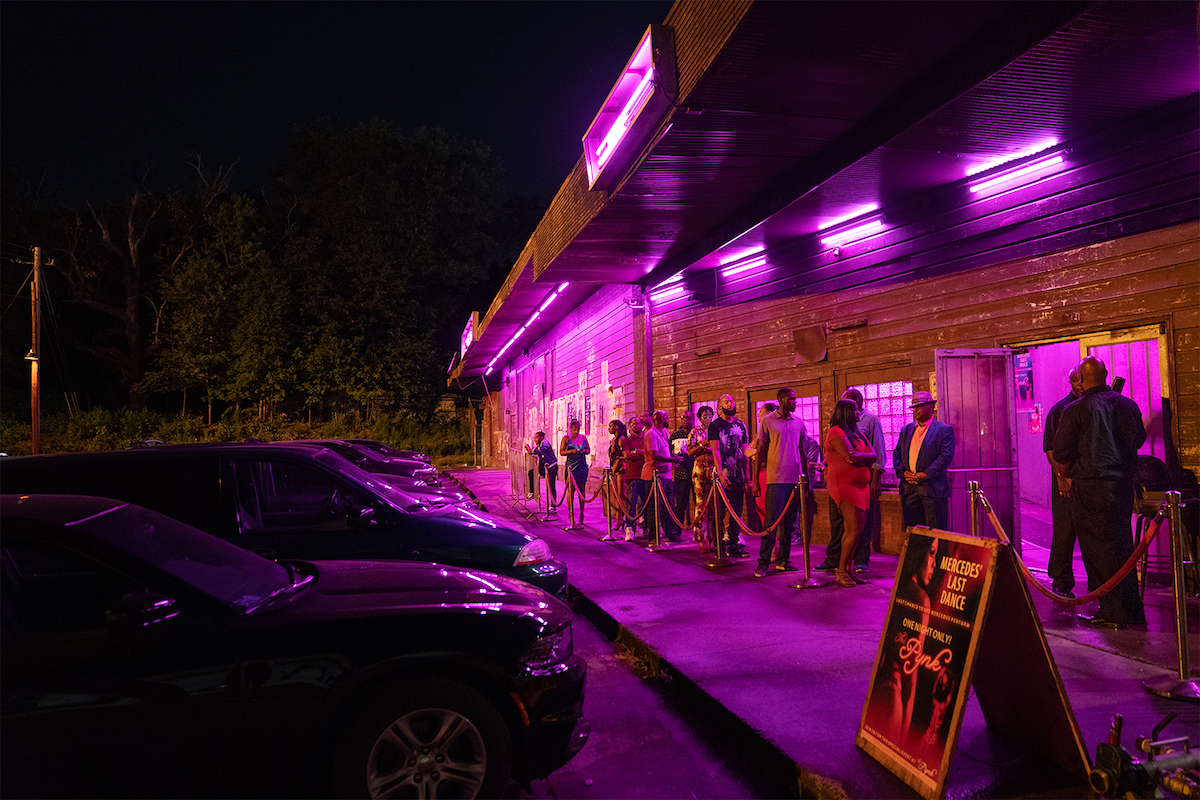
The Pynk is the epicenter of P-Valley, and its interior was built entirely on stage. Finding a building that worked for the outside of the club proved difficult. Production Designer Gordon knew he wanted “a building that felt like it was on the wrong side of the tracks, deep in the Mississippi Delta,” but he drove around for weeks with Location Scout Ekundayo Donegan before finding a crumbling, mold-infested, out-of-code structure on the Tyler Perry Studios backlot, which was set to be demolished within weeks.
“The most important thing for me was to build a sense of history into the place and a backstory of the characters who owned the building beforehand,” relates Gordon, a Georgia local. “It needed to feel like it’d been there for generations. The design had to resonate with the South’s history; maybe it began its life as a cotton mill warehouse. There’s a large cotton motif in this story, and I wanted, in a subtle way, to reference that history, which, of course, can’t be viewed without the context of slavery.”
Gordon says a strip club is a complex environment that begs such questions as: “Who holds the power? Who is in control? Who surrenders?”
“Backstage is where we get to pull back the curtain and find out who the women are,” he adds. “It’s raw and not presented for show. It’s also a place of sisterhood, a reflection of self, love, and arguments; a place to face one’s true reality. The main floor, in contrast, offers fantasy – lights, smoke, mirrors. It’s a place for hope and acceptance, a place to be lost for just a little while.”
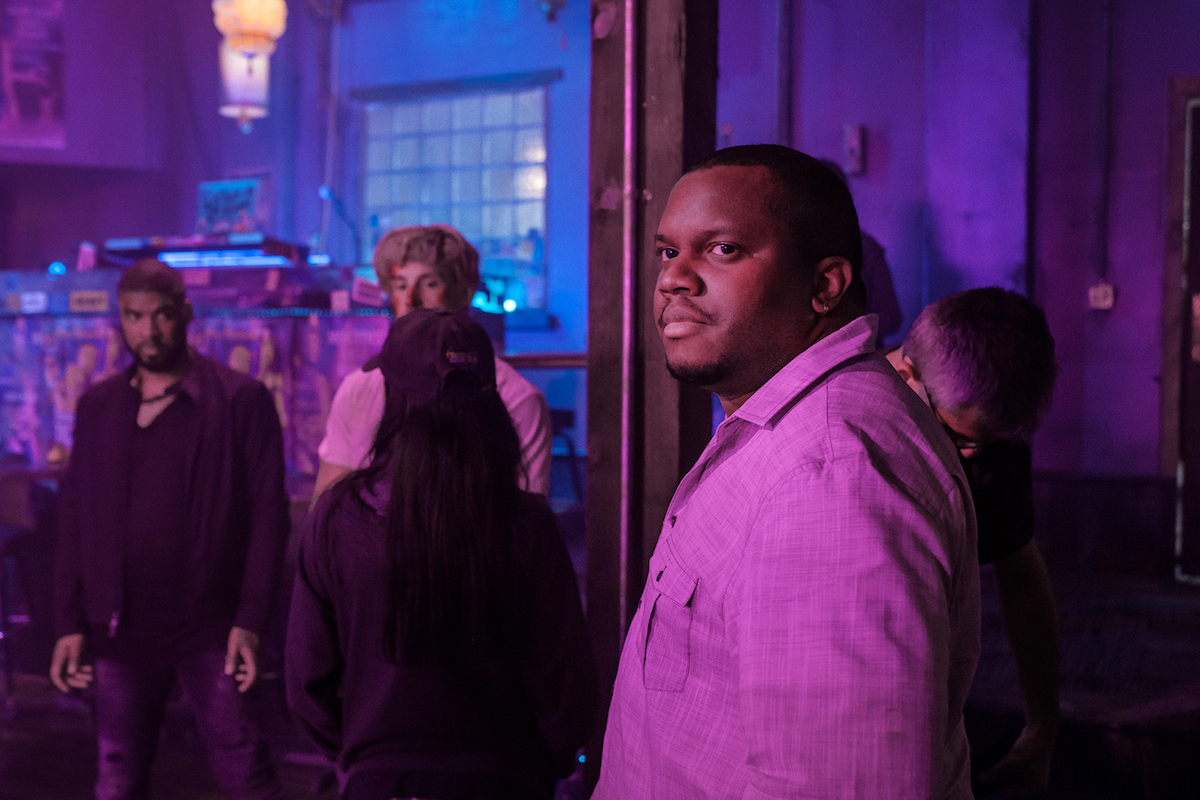
Mirrors, of course, are a camera team’s nightmare, but Gordon says he relished the day he got to show Chameides how he built the eight stage mirrors on gimbals that could swivel in any direction. Gordon says he builds with the utmost awareness of the needs of the camera department, designing a Plexiglass floor that could be put in to capture specialty shots from underneath the stage looking up at the dancers.
Inside The Pynk, Schreiber and Vialet used a trio of ALEXA MINIs, paired with vintage Panavision lenses, customized with the anti-flare coating removed because “we wanted to get flares and broken imagery, keeping it less sterile and polished overall,” says Vialet. “But the flares also helped to push the fantasy that Uncle Clifford and these dancers are selling.”
The lenses were PV Standard Primes de-coated to varying degrees (subtle, medium and extreme). Schreiber and Vialet were interested in the soft feel of the vintage glass, and also the unique aberrations typical of the no-coats. “Due to the nature of the de-coating and the fact that some of them were done decades ago, there was a range of distinct personalities among the no-coats,” describes A-Camera 1st AC Alan Newcomb. “Guy McVicker and Ye Woo Kim at Panavision helped us to supplement our no-coat lineup with Ultra Speed primes and heavily detuned Primo zooms to cover us in situations where the characteristics of the no-coats went in a direction that wasn’t working for the scene, whether it was to achieve a cleaner look where the no-coats were too intense, like windows in the frame, or to provide more intense flaring, particularly with the Ultra Speeds.”
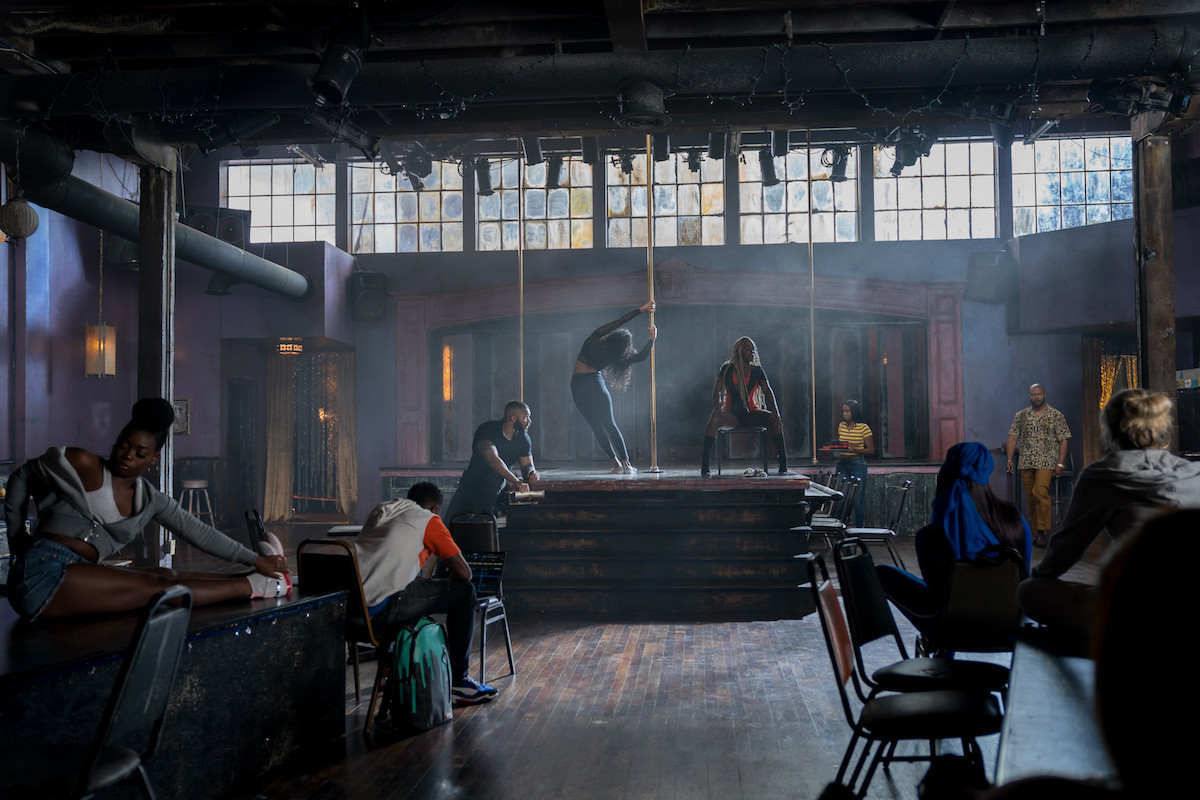
There is a mysterious beginning to Autumn Night’s tale, depicted through flashbacks that are peppered throughout each episode. Schreiber and Vialet wanted to make sure these scenes felt different from those inside The Pynk, so they structured a cool palette and utilized a hefty arsenal of eclectic glass, including Spot and Strip diopters as filtration, sometimes paired with a Lensbaby.
For the first flashback in Episode 1, where Autumn is trying to escape a violent man, Schreiber used a broken diopter McVicker had found, which she combined with a #1 White ProMist filter, smoke and slow motion to keep the violence mysterious. During a flashback in Vialet’s Episode 2, where Autumn is sifting through a suitcase in the aftermath of a flood, he had Newcomb use a Strip diopter to create a broken, fractured feel. “With memory, we are often struggling to recall details; other times we are trying desperately to forget,” Vialet adds. “That’s what we were going for with the flashback scenes.”
The Paradise Room, a place for high-end clients deep inside The Pynk, was another example of visual free-thinking. Gordon had talked with Hall about the cotton motif and its history for Blacks in the South, so he designed a wallpaper that would tell that story.
“I felt it was important, no matter how much the audience clues in,” the designer states. “Something like that can also give the actors visual cues.” The wallpaper featured Mississippi riverboats, cotton blooms, plantation houses, masters on horses, and other slave-era iconography. Initially, Gordon put strippers in the fields as silhouettes instead of slaves, but then ended up transforming them into giant silhouettes of Black strippers on top of the toile wallpaper. “It was the idea of power and control,” he continues. “The toile wallpaper recedes into the background while the silhouettes of the dancers are on top.”
Gordon worked with Ladd to create a storm cloud on the ceiling with Astera tubes that could change the mood depending on the scene, as well as Antebellum-era-style lighting all around. He collaborated with Set Decorator Javed Noorullah to design a sitting area for the patrons that looked like a glowing cloud of cotton, for which they used a translucent chair body covered in fluffy cotton, with Ladd building-in lights that could change color. While Hall desired to keep the room blue, Vialet was worried about a tip into muddiness and a tendency to look too much like blacklight. As a counter, he put hints of orange glow behind Gordon’s plantation columns in the corners of the room for contrast.
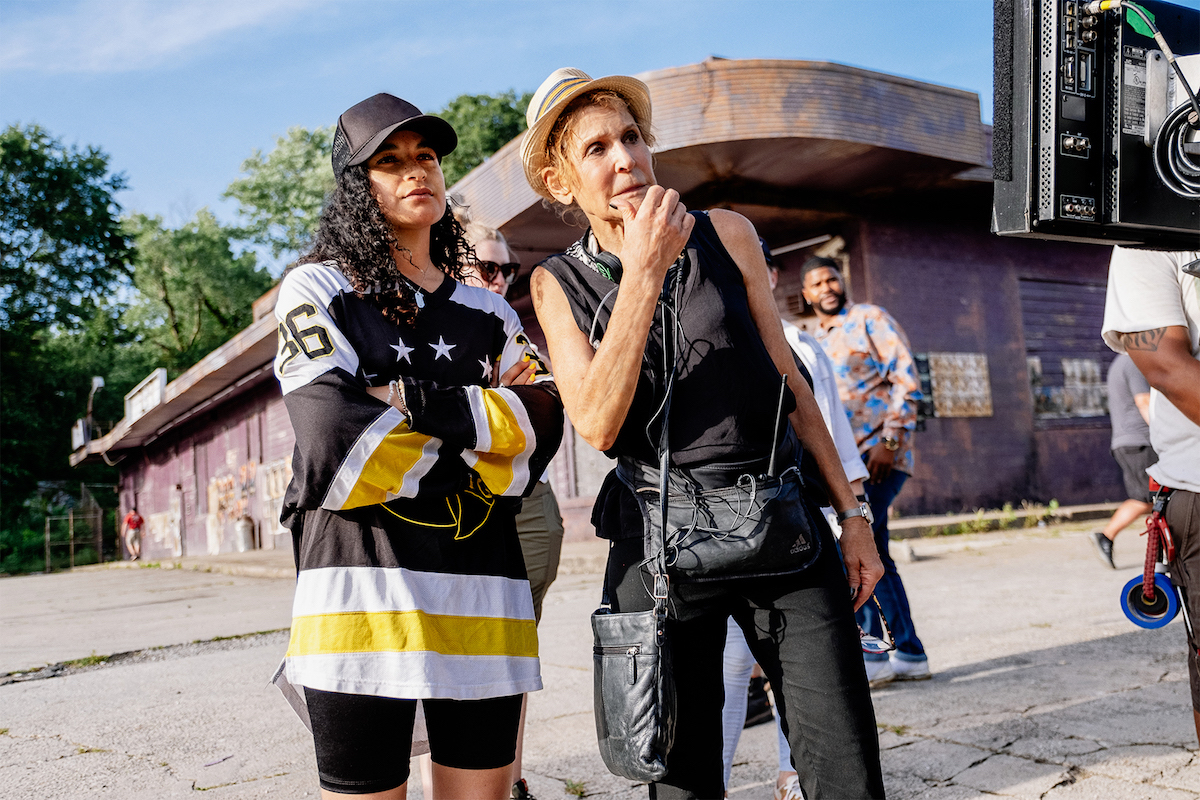
Historically, women’s bodies in the media have been hyper-sexualized, all the more so with Black women. The Pynk is, of course, a strip club and sexuality is its stock and trade; but Hall, Schreiber and Vialet wanted to push up against the idea that the imagery of the dancers’ bodies had to be strictly sexual. Pole dancing is extremely rigorous, with dancers bruising, falling, slipping, and enduring skin burns from the metal in a typical workday, and P-Valley does a tremendous job of showing that hard reality.
“The story is written from a woman’s experience,” Hall concludes, “so at the center of the narrative there is the journey of a woman who [frames the show through a] female gaze.” That meant Hall did not want the camera to linger on bodies; it could “appreciate and love up on a woman’s body,” as she describes, but there was never a gratuitous frame or a cut-up body. The camera would see each woman’s form as a whole entity, integrated with the character’s POV, and therefore her experience.
“The women in our series are embraced for their strength, dignity and empowerment as they work the floor and poles,” Schreiber says. “These are not the androgynous ultra-skinny models in advertising. These are real women with beautifully defined muscles and curves.”
Schreiber remembers the first time they filmed Mercedes (Brandee Evans), the OG stripper at The Pynk: “The entire crew held their breath as she climbed the pole, twisting and turning her body to the ceiling, then dramatically dropping to the ground into the splits. An audible gasp could be heard from club-patron extras and crew alike, even over the loud music. I doubt Production was happy about her pushing the limits – we did have body doubles to ensure the safety of our main cast. Brandee, of course, has been a dancer for years and had been rehearsing on the pole for months before production ever began. She was more than capable of handling such athletic maneuvers; and like everyone connected with this ground-breaking show, it was inspiring to see her in action.”
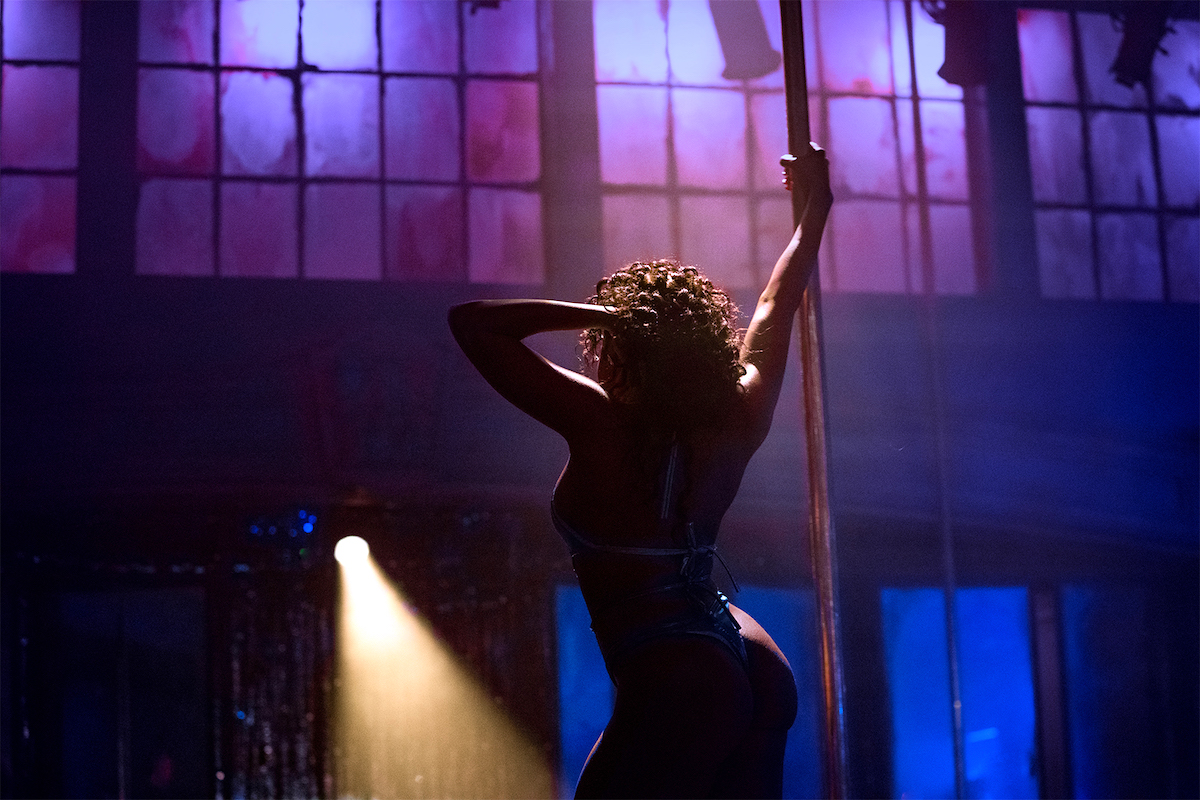
Local 600 Camera Team : P-Valley
Directors of Photography: Nancy Schreiber, ASC, Richard Vialet
A-Camera/Steadicam Operator: Dave Chameides, SOC
A-Camera 1st AC: Alan Newcomb
A-Camera 2nd AC: Callie Moore
B-Camera Operator: Janice Min
B-Camera 1st AC: Brian DeCroce
B-Camera 2nd AC: Nubia Rahim
DIT: Chris Ratledge
Loader: Erin Strickland
Utility: Chandra Sudtelgte
Still Photographers: Jessica Miglio, SMPSP, Tina Rowden, Erika Doss, Eliza Morse, Kyle Kaplan
